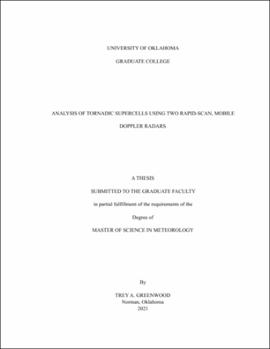| dc.description.abstract | Mobile Doppler radar is a critical tool in studying microscale phenomena, including tornadoes, in supercell thunderstorms at close-range. However, a relative dearth of high-quality cases documenting the tornadic life cycle has hindered the advancement of our understanding of tornado evolution, storm-scale processes related to tornadogenesis and decay, and why some supercells produce tornadoes and others do not. Four tornadic events occurred in Oklahoma during the springs of 2015 and 2019, each documented by either the Mobile Weather Radar, 2005 X-Band, Phased Array (MWR-05XP), the Rapid X-band Polarimetric (RaXPol) radar, or both. In this study, these cases will be thoroughly analyzed with emphasis on the following points:
1) Tornadogenesis and decay (whether the tornado vortex signature (TVS) builds upward or downward with time) when applicable,
2) how the TVS as a function of height evolves over time,
3) vortex tilt as a function of height and its evolution over time, and
4) any unique features evident in the data, particularly those that yielded changes to the behavior of the vortex or that have rarely been documented in previous studies.
Among the four cases, both descending and nondescending tornadogenesis were documented, as was “inside-out” decay, as described in French et al. (2014) and Houser et al. (2015). A majority of the tornadic vortices were highly tilted; vortex tilt was compared to the environmental hodograph (either modeled or observed) in close proximity to each parent supercell, a technique that, to the author’s knowledge, has not been employed previously. In addition, several interesting features were noted, including tornado debris signatures and weak-echo columns (the characteristics and behavior of which will be discussed), and the majority of the supercells exhibited subtornadic vortices that were, generally, only apparent aloft and displayed unique behavior. | en_US |
